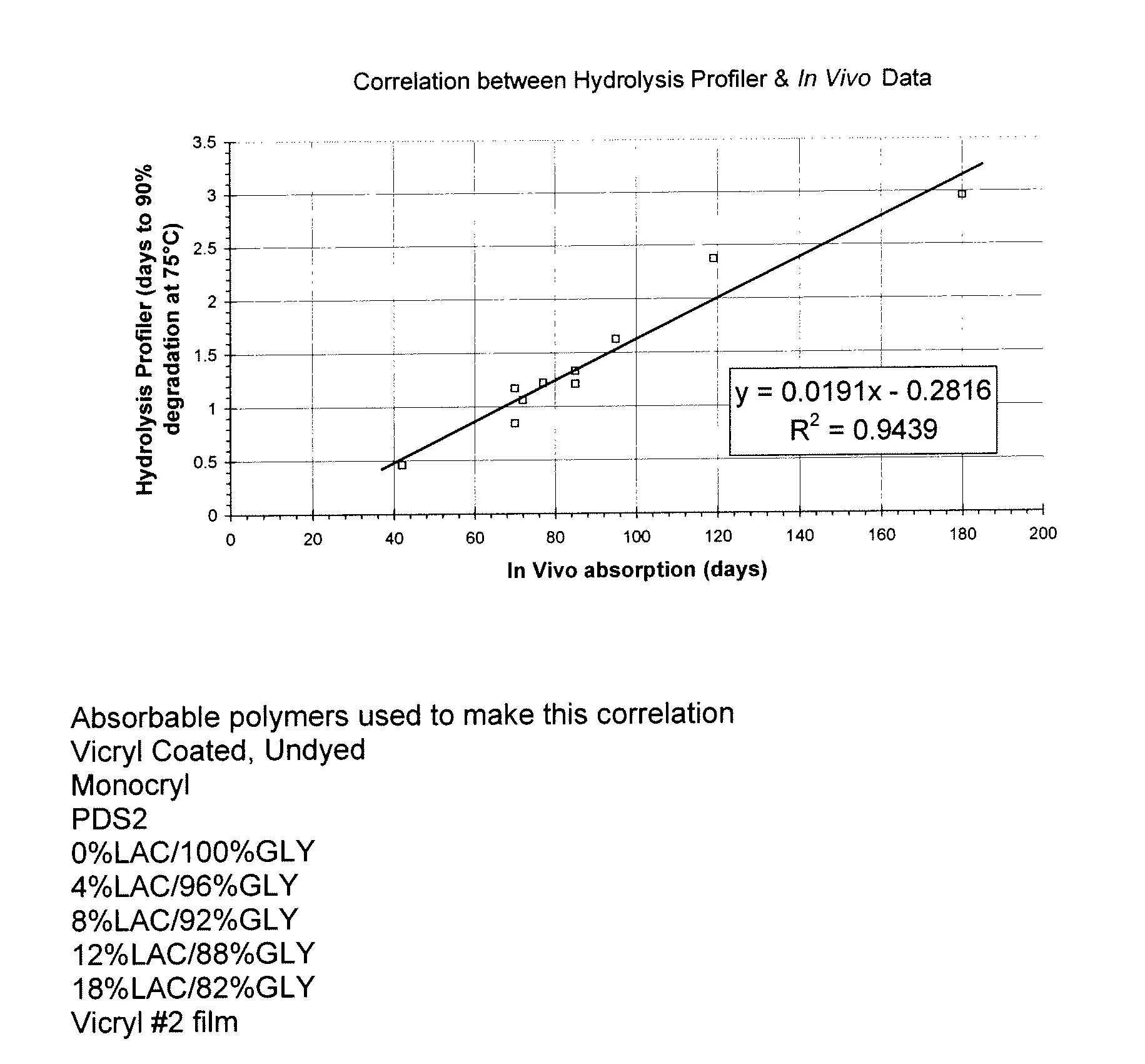Absorbable polymer formulations
a polymer and absorbable technology, applied in the field of absorbable polymer formulations, can solve the problems soft tissue repair or augmentation, soft tissue defects, etc., and achieve the effects of short-lived collagen treatment benefits
- Summary
- Abstract
- Description
- Claims
- Application Information
AI Technical Summary
Problems solved by technology
Method used
Image
Examples
example 1
Synthesis of Hydroxy Terminated Poly(ethylene diglycolate) (PEDG)
[0044]A twin-agitated reactor with intermeshing HELICONE patterned blades (Atlantic 10CV reactor) was employed. After charging the reactor with 10.0 kg of diglycolic acid, 13.9 kg of ethylene glycol (EG) and 1.86 grams of dibutyltin oxide catalyst, the pressure was reduced to below 1 Torr and the vacuum preserved over night. The next day vacuum was released with dry nitrogen (argon can be substituted) and the heating of mixture started. When the reactor temperature reached 150° C., an agitator speed was set to 30 RPM. Soon first distillate appeared containing mostly water, an esterification by-product. The reaction was continued at 165° C. for a couple of more hours until approximately all water was distilled and / or first traces of EG appeared in the distillate. After the first nitrogen / argon stage was completed, pressure was lowered gradually to full vacuum in steps while the temperature of the batch was maintained at...
example 2
[0045]Example 2 includes general description of the copolymerization step; specific examples of the individual samples follow in Examples 2A, 2B and 2C.
Co-Polymerization of Hydroxy Terminated Poly(ethylene diglycolate) with a Lactone Monomer, Epsilon-Caprolactone
[0046]A portion of the Polyethylene diglycolate made in Example 1 was added into an oven dried 250 milliliter round bottom flask. In the nitrogen glove box, the e-caprolactone and catalyst were charged. A mechanical stirrer, nitrogen adapter and stirrer bearing were added to the 250 ml flask's neck opening. The vessel was pulled under a vacuum of less than 500 mTorr at room temperature and held overnight. The polymer was reacted using a stepped temperature profile. The next day the flask was released to nitrogen and placed in the oil bath. The bath temperature was set to 120° C. without agitation. Once the temperature reached approximately 95° C. the mechanical stirrer was set at 4 RPM. When the temperature reached 120° C., ...
example 2a
The Copolymerization of Hydroxy Terminated Poly(ethylene diglycolate) with a epsilon-Caprolactone
PEDG / Cap 50 / 50 wt. %
[0048]A portion of the Poly(ethylene diglycolate) made in Example 1 (50 g) that was discharged after 28 hours (IV=0.25 dL / g) was placed into an oven dried 250 milliliter round bottom flask. In the nitrogen glove box, the e-caprolactone (50 g) and catalyst, stannous octoate (0.022 mL) were charged. A mechanical stirrer, nitrogen adapter and stirrer bearing were added to the 250 ml flask's neck opening. The vessel was pulled under a vacuum of less than 200 mTorr at room temperature and held overnight. The next day the flask was released to nitrogen and placed in the oil bath. The bath temperature was set to 120° C. without agitation. Once the temperature reached approximately 95° C. the mechanical stirrer was set at 4 RPM. When the temperature reached 120° C., the oil bath setpoint was increased to 160° C. and the mixing was increased to 6 RPM. When the melt appeared ho...
PUM
| Property | Measurement | Unit |
|---|---|---|
| Tg | aaaaa | aaaaa |
| Tg | aaaaa | aaaaa |
| glass transition temperature | aaaaa | aaaaa |
Abstract
Description
Claims
Application Information
 Login to View More
Login to View More - R&D
- Intellectual Property
- Life Sciences
- Materials
- Tech Scout
- Unparalleled Data Quality
- Higher Quality Content
- 60% Fewer Hallucinations
Browse by: Latest US Patents, China's latest patents, Technical Efficacy Thesaurus, Application Domain, Technology Topic, Popular Technical Reports.
© 2025 PatSnap. All rights reserved.Legal|Privacy policy|Modern Slavery Act Transparency Statement|Sitemap|About US| Contact US: help@patsnap.com

